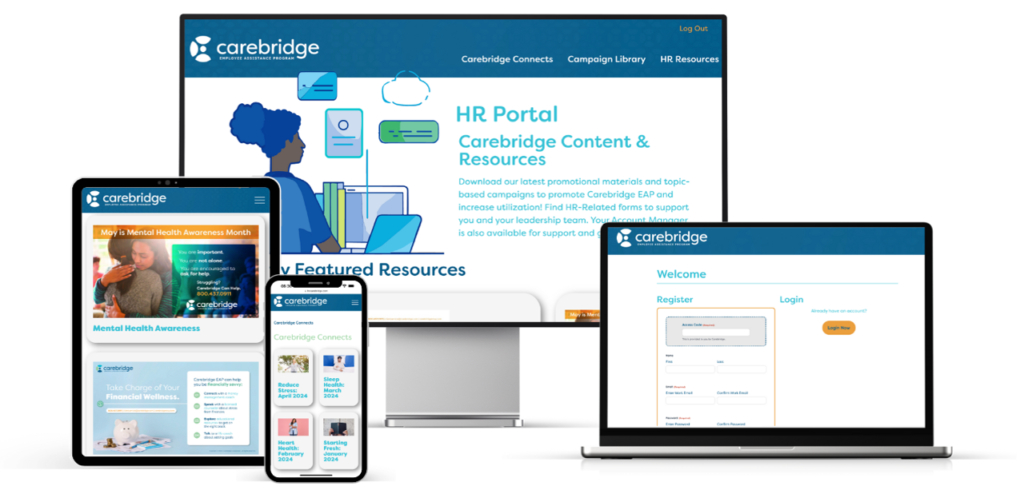Why Employees Don’t Use Your EAP (and How to Increase Utilization!)
Employee Assistance Programs (EAPs) offer essential support such as mental health counseling, wellness coaching, financial guidance, and legal advice. Yet many employees don’t fully utilize these benefits. The question is, why? If your company has invested in an EAP but utilization rates are low, it’s worth exploring the potential barriers that might be preventing employees from accessing this valuable resource.
Here are some common reasons why employees may not use EAP services and actionable steps HR, benefits, and leadership teams can take to increase engagement:
1. Lack of Awareness
One of the most frequent reasons employees don’t use their EAP is simply a lack of awareness. If employees aren’t familiar with the program or forget that it’s available, they’re less likely to take advantage of the benefits.
Enhance Communication Frequency and Timing
EAPs are often only highlighted during Open Enrollment or new hire onboarding—times when employees are already absorbing a lot of information. As a result, they may focus more on benefits they directly contribute to, like healthcare plans or 401(k)s, leaving EAPs overlooked. A more effective approach is to promote your EAP year-round, regularly reminding employees how to access it and why they will benefit.
Empower Managers
Managers play a crucial role in creating awareness about the EAP. If managers aren’t familiar with the program’s offerings, they may miss opportunities to recommend it to their team or recognize when a referral might be appropriate. Equipping managers with EAP training can help them become champions of mental health within your organization.
Leverage Marketing Content
Many EAP providers offer free marketing materials and host events to promote their services. These are often content pieces that educate readers on a variety of wellness campaigns such as mental health, physical wellbeing, financial planning, and caregiving. Taking full advantage of these resources increases awareness of the EAP while reduces the stigma of accessing mental health support.
Pro Tip: With an EAP like Carebridge you’ll receive exclusive access to our HR Portal where there are 100s of digital marketing content (like articles, infographics, flyers, and short-form videos) that educate your employees and promote how our various services and tools can help them.

2. Misunderstanding the Full Purpose and Value of an EAP
The second most common reason an employee may not utilize their EAP is they have misconceptions about why the benefit exists.
Clarify How EAPs Aren’t Just for Crisis Situations
Employees may mistakenly believe that EAPs are only meant for those in crisis or needing counseling. This misconception can limit their interest in using the program. In reality, comprehensive EAPs often provide a wide range of services, including:
- Proactive Coaching
- Work-life Assistance
- Manager Consultations
- Career Development Strategies
- Financial Wellness
- Legal Advice
EAPs can do even more! Check out 60 Ways to Use Your EAP
Acknowledge Overlap with Existing Benefits
Some employees might think that if they already have access to counseling through their healthcare plan, the EAP isn’t necessary. However, many EAPs are designed to complement healthcare benefits, ensuring continuity of care. Clearly communicating this can help employees understand how the EAP can be an additional resource for them with no out-of-pocket costs or co-pays.
Pro Tip: Consider asking employees to volunteer their real-life success stories using various services of the EAP. You might be surprised how many are willing to share their personal experience!
3. There are Larger Concerns With Your Workplace Culture
A healthy workplace culture is critical for EAP success. Even the best EAP cannot fully compensate for a challenging or toxic work environment. If employees face issues like micromanagement, unresolved conflicts, excessive workload, or lack of psychological safety, these underlying issues can discourage them from seeking support.
Build Trust in Confidentiality
In some workplace cultures, employees may worry about confidentiality. They might fear negative consequences if management becomes aware that they sought help through a company benefit. It’s crucial for organizations to communicate that EAP services are confidential and are genuinely provided to support employee wellbeing—not to penalize those who use them.
Promote the EAP as a Positive Resource, Not a Punishment
If the EAP is positioned as a last resort or something employees are directed to only when performance slips, it can be perceived negatively. Instead, focus on promoting the EAP as a resource for all employees by encouraging its use as a proactive measure for overall wellbeing.
Pro Tip: Address workplace culture issues head-on. Foster a transparent, supportive environment where employees feel safe seeking help without fear of judgment or retaliation. Build trust in the EAP’s confidentiality and assure employees that their privacy is protected.
Maximize EAP Utilization
If your employees aren’t using your EAP, it’s likely not because they don’t need support—it’s more often due to a lack of awareness, misunderstanding of its value, or confidentiality concerns. By increasing communication, clarifying the EAP’s offerings, leveraging marketing materials, and addressing workplace dynamics, you can help employees feel more comfortable accessing this valuable benefit.
Carebridge Can Help.
While creating a healthy workplace culture starts within, a comprehensive EAP like Carebridge can play a key role in supporting HR and leadership teams. We offer group manager trainings, online courses, unlimited consultations, and conflict management support. Connect with our sales team today to learn more at sales@carebridge.com.